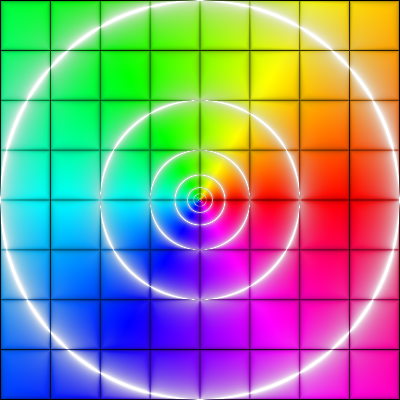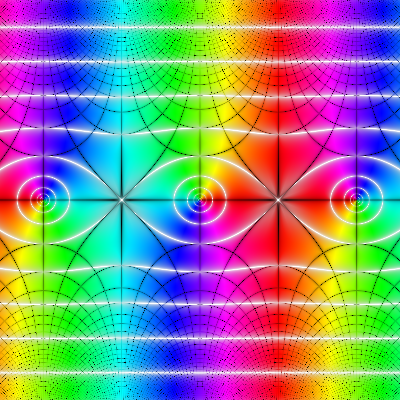Complex domain coloring
Colorz is a fun tool that generates domain coloring for the given function of a complex variable z.
In other words, colorz is yet another implementation of:
- http://www.jedsoft.org/fun/complex/
- http://mathematica.stackexchange.com/questions/7275/how-can-i-generate-this-domain-coloring-plot
- Copy colorz into your convenient directory.
- Windows users need to copy colorz.bat into the same directory.
- *nix users may need executable permission (chmod +x colorz).
- Include the directory in PATH.
Try below:
$ colorz
After a few seconds, the command prints a full path to the generated PNG file and ends.
$ colorz /working/dir/colorz.png $
The generated colorz.png is a domain coloring result of f(z) = z, where z covers from -4-4i to 4+4i.
The color in a point represents the result value of f(z) at the corresponding point on the complex plane. The hue represents the phase, as many other domain coloring methods do. A white(bright) point means the magnitude is quite near one of 2^n (n: integer including negative numbers). A black(dark) point means either the real part or the imaginary part is an integer.
Try the sine function:
$ colorz "sin(z)"
More examples are in gallery.
$ colorz -h
Complex domain coloring
Usage: colorz [options] FUNCTION
Options:
-d, --domain=MIN,MAX coloring domain (e.g. -d=-2-2i,+2+2i)
-i, --input-file=INPUT_FILE file path of ruby script for a complex function
-o, --output-file=OUTPUT_FILE file path of output image
-s, --size=WxH size(width=W, height=H) of the output image
-t, --tile the right/bottom edge shows slightly inner values than the maximum
FUNCTION:
Ruby snipet that returns a value with a given parameter "z"
Plot twice as large as the target size. When you want a 400x400 image of f(z) = 1/z for example:
$ colorz -s 800x800 -o inv2.png "1/z"
Then shrink the image to the target size. If you have ImageMagick, convert command can do that:
$ convert -geometry 400x400 inv2.png inv.png
Otherwise you will see a flood of warnings "warning: already initialized constant..."
The function below fails as invalid option:
$ colors "-z"
Avoid minus sign "-" at the beginning. e.g. "0-z".
On this tool, I prefer visual sweetness rather than the mathematical correctness.


